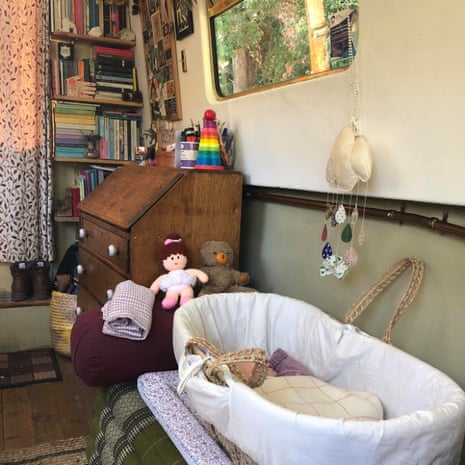When people find out that I live on a narrowboat, their eyes light up. They say things like “Gosh, I’d love to do that,” and “That’s so bohemian of you!,” and “It must be so peaceful”. It is peaceful, sometimes, but it’s easy to forget that when you’re struggling to push open a heavy lock gate in the pouring rain with a screaming baby strapped to your chest. Still, I love the way I live: I love being close to the water, and feeling more connected to nature and in sync with the changing seasons than I did living on land.
That isn’t to say boat life was always the plan. I used to imagine I’d end up in some rambling old farmhouse, with Farrow & Ball wallpaper, period features and an open fire. I still get pangs when I visit friends’ seemingly enormous and lavishly equipped houses – upstairs and downstairs! A freezer! Hot taps! But for my husband, Nigel, and I, with our ill-paid, bookish jobs (I’m a writer, he’s a librarian. OK fine, my ill-paid job) along with, you know, The Economy, buying a house just isn’t feasible, especially where we live in Oxford. But owning his own home has always been important to Nige, who grew up in council housing, so we began to explore alternative options. Once we let go of the impossible goal of a house and focused instead on what we could afford, everything changed.
We talked about buying a narrowboat in a half-joking, half-dreaming sort of way. Sure, it was (more or less) in our price range, but was it really for us? It seemed picturesque, but it also seemed difficult and daunting. It seemed like something other people did; braver people. Then one day, after receiving some bad news about my progesterone levels (we’d been struggling to get pregnant for a while), I realised that, if we couldn’t have babies, I wanted to live as adventurously as possible. We decided to just go for it.
We scraped together what savings we had, took out multiple loans and eventually managed to secure a boat mortgage (they’re a thing), before finally buying our narrowboat in July 2021. We spent the summer doing her up: I learned to tile and managed to figure out the plumbing, Nige laid down new pallet-wood floors, and my mum helped us paint. In September, we moved aboard full-time. Our daughter was born the following August.
Happily, it turns out motherhood and adventure need not preclude each other, though having a baby on a narrowboat does present certain challenges. I was sad not to have a nursery in which to unleash all my hormone-induced nestiness, but coming up with creative storage solutions is oddly satisfying, and I like having pretty mobiles and toys in our main living area. The recent cold snap was a worry, though we managed to get through it with some well-timed weekend visits to friends, and a few nights camping out by the stove (a mini-adventure in itself). I’m mildly concerned about what we’ll do when our daughter starts school, but for now I’m thrilled to be raising her surrounded by nature and the boating community.
We’re what’s called “continuous cruisers”, which means we move our boat to a new mooring roughly every two weeks. It doesn’t mean we flit between a few favourite places: the rules state that we must “genuinely navigate the waters”, and I’ve heard of boaters’ licences being revoked because they haven’t covered enough distance. Permanent moorings do exist but they rarely become available, and are often prohibitively expensive. Plus, gallingly, it is actually much easier to find one if your boat is your second home: many long-term spots come with the caveat that, while your boat is welcome to stay put for 365 days of the year, you may only live aboard it for two-thirds of that time. Luckily, continuous cruising has benefits: moving every fortnight means we’re always bumping into boaters we know, which is lovely, and the sense of freedom is unparalleled.
We’ve certainly had some challenging moments – like when our batteries died and we spent five days in candlelight, or when we accidentally left the cat behind, or every single time I use the toilet (it’s literally a bucket in a box) – but I love our floating home. I have fewer possessions, but I’ve gained a lot: I’ve learned how to slow down and be gentle with myself, to hear the birds and see the stars.
I’m extremely glad to have escaped the toxic grip of the rental market, and to have left behind the pressure of owning a bricks-and-mortar house on land. Living off-grid, I have a new appreciation for water, warmth and light. I feel braver. A lot of people say they’d love to live on a narrowboat, but not many find the courage to give up the familiar comforts of life on dry land. I’m glad I did.
Faye Keegan is a freelance writer
Do you have an opinion on the issues raised in this article? If you would like to submit a response of up to 300 words by email to be considered for publication in our letters section, please click here.

